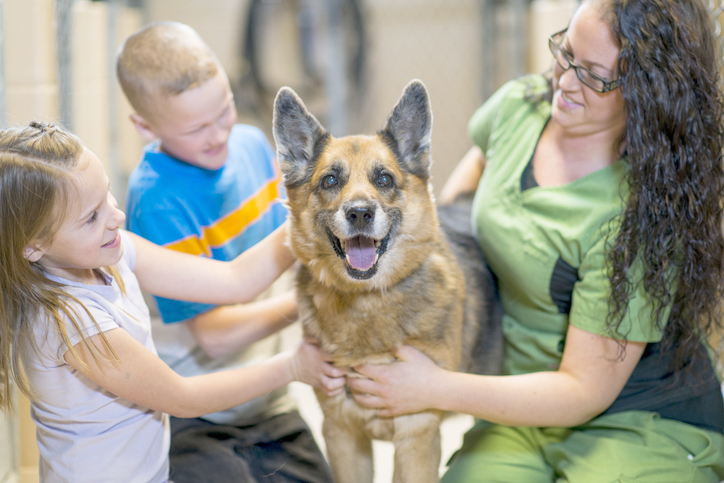Though October is the official Adopt a Shelter Dog month sponsored by the American Society for the Prevention of Cruelty to Animals (ASPCA), every month presents an opportunity to open your home to a shelter animal.
Each year, “[a]pproximately 6.3 million companion animals enter U.S. animal shelters nationwide every year,” the ASPCA shares. And although those numbers are on the decline from the 7.2 million animals estimated to be entering in shelters a decade ago, the number is still high. Almost a million of those animals will be euthanized before finding a loving home. Happily, about 4.1 million shelter animals are adopted annually.
In Greene County and surrounding areas, a small number of shelters and rescues are working with rescued animals. These groups – the Greene County Humane Society, Catnip Acres, Teddy Bear Care, and Two Ladies Four Paws – are dedicated to finding homes and companionship for shelter pets, reducing the number of feral animals, and saving neglected and mistreated animals. Other animal rescue efforts in the area include Save A Horse, which is dedicated to providing horses a safe place to spend the remainder of their lives.
Most of the rescues and organizations are facing a shared crisis – lack of volunteers. Rescues rely on volunteers to assist with fundraising, animal, care, fostering and more. “On top of the rescue and clinic, our humane officers’ calls have increased 80% in the last few months, as we are doing 90% of the humane calls in Greene,” Tanya, a volunteer with Catnip Acres says. “We have taken in dogs, rabbits, turtles, guinea pigs, and much more, on top of cats. We desperately need fosters to house these animals that are outside of our scope of rescue.”
And the number of kittens to be cared for outnumbers the total homes they have for fostering: “We need more fosters to be able to continue taking in kittens. We cannot do it all alone,” says Tanya.
Because the work is often hard and dirty, new volunteers are hard to come by. ”A lot of people see those sad posts or commercials and change the channel or keep scrolling,” says Kate Sears from Two Ladies Four Paws. “Even if you can’t adopt or foster, you can volunteer, donate and educate.”
The hardest part of attracting new volunteers is reaching the younger generations. These younger generations are integral to the longevity of nonprofits like Catnip Acres. As older volunteers become unable to assist, younger volunteers can step up and continue the nonprofit’s work. Volunteering with local rescues can take many forms: fundraising, accounting, animal care, socializing and more.
Another mutual problem is funding. Thanks to COVID-19, most rescues have been unable to have the fundraising events they rely on to stay open. Most rescues run on donations, although grants are sometimes available to help with operating costs. Donations from the public are always welcome and no donation is too small. Without the money raised through donations, the rescues will have to shut their doors. Many of the rescues are forced to use a large portion of their founder’s personal funds to maintain operations. “As a nonprofit, we have to fight for donors’ attention,” says Kate.
Added fundraising issues tie back to the first problem – volunteers. Because rescues operate with a limited number of volunteers, those volunteers have their hands full with humane calls and basic operations. They are left with no time to work on fundraising or hold events. Volunteers willing to assist with fundraising are just as important to those that provide animal care.
An additional problem that Catnip frequently sees is ignorance. Overpopulation is a serious problem affecting many Greene County towns. Catnip continues to educate the community on the benefits of spaying and neutering their pets, and it often seems that no one listens. This year has been especially hard for them with an influx of kittens. “This past year, not one of the free clinics were at capacity or even close. The community did not take advantage of this at all,” Tanya says. “[People] are angry at rescues for not being able to take in anymore because they didn’t do their part to curb this issue.”
Before starting Catnip Acres, Carol Pultorak worked as a volunteer for the Humane Society and quickly became aware of the number of cats euthanized due to lack of space and increasing numbers. She became determined to minimize the number of cats euthanized and “find a way to spay and neuter every cat in Greene County.” The nonprofit was officially created in April 2007 and began to provide a high volume of high-quality, low-cost sterilizations. Through sterilization and vaccination, Catnip Acres decreases population, thereby decreasing animal abuse, neglect, disease, and overcrowding shelters.
The public is an integral part in reducing overpopulation. The rescues do not have the manpower to be everywhere, completing all the aspects to help prevent overpopulation. Community members can trap and bring in feral animals to be spayed or neutered or can adopt nearby strays and provide them a safe home indoors. Community involvement also helps minimize costs for the rescues: “It is crucial that we have the financial support of this county to continue doing the essential work that seems endless. Catnip Acres provides a great service to this community, and we all love what we do. We have the ability to enhance the health and well-being of Greene County’s animals, but only with the help of this county.”
“[D]oing rescue work is so rewarding. It is hard, rescue takes a toll on you physically, but more so emotionally. However, the good outweighs the bad in every way. To save a life that has no voice in this world is a gratifying job,” says Tanya.
